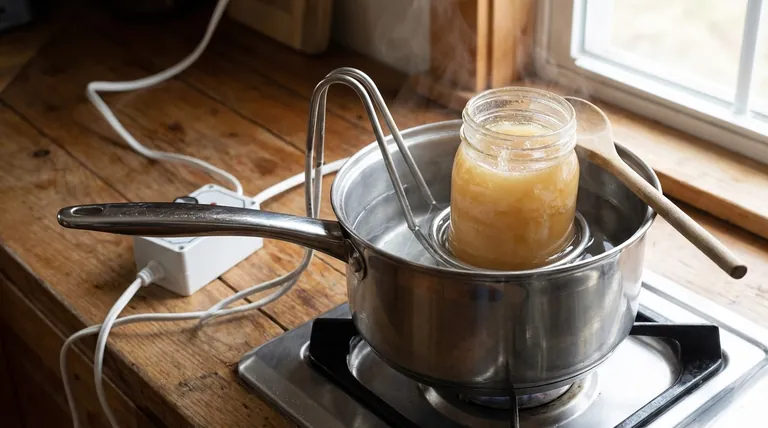The single best way to liquefy crystallized honey is to gently warm the jar in a pot of hot water. This indirect heating method safely dissolves the glucose crystals that cause hardening without overheating the honey, which would destroy its beneficial enzymes and alter its delicate flavor.
Crystallization is a natural sign of pure, unprocessed honey, not a sign of spoilage. The goal is to reverse this process using gentle, indirect heat, thereby preserving the honey's unique flavor, color, and beneficial properties.

Why Honey Crystallizes in the First Place
A Natural and Reversible Process
Crystallization, also known as granulation, is the process where honey transitions from a liquid to a semi-solid state. This is not spoilage; it is a natural characteristic of pure honey.
The process is entirely reversible without damaging the product, provided it is done correctly.
The Science of Sugars
Honey is a super-saturated solution of two main sugars: glucose and fructose. Glucose is less soluble in water than fructose, so it has a natural tendency to crystallize out of the solution.
Honeys with a higher glucose-to-fructose ratio will crystallize much faster than those with a lower ratio.
The Guiding Principle: Gentle, Indirect Heat
The Goal is Melting, Not Cooking
When you warm honey, you are simply re-dissolving the solid glucose crystals back into the liquid. This requires only a minimal amount of gentle, sustained warmth.
The objective is to raise the temperature just enough to achieve this melting effect and no further.
Why High Heat is the Enemy
Exposing honey to high temperatures fundamentally changes its composition.
Excessive heat will destroy the beneficial enzymes and antioxidants that make high-quality honey so valued. It can also caramelize the sugars, which permanently alters the flavor profile and darkens the color.
The Problem with Microwaves
Microwaving is not recommended because it heats honey too quickly and unevenly. This creates "hot spots" that can easily scorch the honey, caramelizing the sugars and destroying its quality long before the entire jar is liquefied.
The Best Method: A Step-by-Step Water Bath
Step 1: Prepare the Jar
First, ensure your honey is in a glass jar, as plastic can warp or leach chemicals when heated. Simply loosen the lid of the jar; you do not need to remove it completely.
Step 2: Create the Water Bath
Place your jar of honey into a saucepan. Fill the pan with enough warm water to come up the sides of the jar, but not so high that it could spill into the honey.
Step 3: Heat Gently and Stir
Place the saucepan on a stove over the lowest possible heat setting. The water should be warm to hot, but never simmering or boiling.
As the honey warms, stir it occasionally to distribute the heat and speed up the process. Continue until all crystals have dissolved and the honey is smooth.
Alternative: Electric Heating Blankets
For beekeepers or those with large quantities, electric honey warmers or heating blankets are excellent tools. They wrap around the container and provide low, consistent heat for a prolonged period, liquefying the honey perfectly while requiring minimal supervision.
Understanding the Key Trade-off: Speed vs. Quality
Quality Requires Patience
The most common mistake is trying to rush the process. Applying higher heat will liquefy the honey faster, but it comes at the direct expense of its quality. The slow, low-temperature water bath method is designed to prioritize the preservation of flavor and beneficial compounds.
The Risk of Overheating
Remember, any damage from overheating is permanent. You cannot reverse a change in flavor caused by caramelized sugar or bring back enzymes that have been destroyed. The risk of a faster method always outweighs the reward.
Making the Right Choice for Your Honey
- If your primary focus is preserving maximum quality: Use the slow, low-temperature water bath method described above. Be patient, as it may take an hour or more for a fully crystallized jar.
- If you are dealing with a plastic container: Be extremely cautious. Use only warm (not hot) water to prevent the plastic from warping. For best results, consider transferring the honey to a glass jar before heating.
- If you only need a small amount: Scoop the crystallized honey you need into a small glass bowl and place that bowl in a larger container of hot water until it liquefies.
By understanding the principle of gentle heat, you can confidently restore any jar of crystallized honey to its perfect liquid state.
Summary Table:
| Method | Key Principle | Best For |
|---|---|---|
| Warm Water Bath | Gentle, indirect heat | Preserving quality for home use |
| Electric Heating Blanket | Low, consistent heat | Beekeepers & large quantities |
| Avoid Microwave | Prevents hot spots & scorching | Maintaining honey's beneficial properties |
Need to liquefy honey at scale while preserving its premium quality? HONESTBEE supplies commercial apiaries and distributors with professional-grade honey warming equipment designed for efficient, gentle heating. Our solutions ensure your product retains its valuable enzymes and flavor profile. Contact our wholesale experts today to find the right equipment for your operation!
Visual Guide

Related Products
- Professional Thermostatic Conical Honey Melter
- Honey Concentrating Vacuum Heating Thickening Machine Dehumidifier for Honey
- 10L Stainless Steel Electric Honey Press Machine
- Electric 8 Frame Honey Spinner Extractor Equipment for Beekeeping
- 0.5T Capacity Honey Dehumidifier Dryer with Vacuum Heating and Thickening Filtering Machine
People Also Ask
- Why is heating honey sometimes necessary? The Essential Guide to Processing & Quality
- What is the effect of heating on honey? Preserve Quality with Controlled Warming
- How does the Bee Blanket help maintain honey quality? Preserve Enzymes with Gentle Hive-Mimicking Heat
- Why is it important to heat honey slowly and evenly? Preserve Flavor, Nutrients & Value
- At what temperature does honey flow? Preserve Quality with the Perfect 95°F Sweet Spot



















